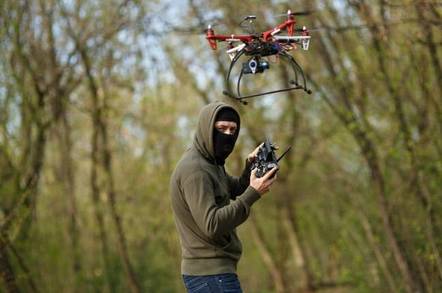The FAA (Federal Aviation Administration) has proposed two methods to identify and track drones. One of the reason the FAA wants to be able to identify drones is because criminal elements have used drones to disrupt police/FBI operations and also spy on them.
Per an article on the AOPA website, “two basic methods for tracking and identification of drones: The first option is to use data broadcasted directly from the drone, and encoding digital identification information into the radio signals exchanged between the drone and controller; the alternative is to use a “network publishing” approach, in which the drone data would be transmitted to an internet service during flight, which could in turn be accessed by law enforcement agencies. Committee members representing law enforcement expressed a preference for direct transmission (which could also include programming a unique pattern of flashing the LEDs installed on most drones in a signature pattern that is readable by a device on the ground), to maintain the capability to identify a drone in areas where cellular or other data networks are not available.”
Here is one of the reasons why the FAA wants a method to identify who a drone is being flown by, from Fox News, “This past winter in a US city, criminal suspects used drones against an FBI hostage rescue team to flush out the federal agents, according to Joe Mazel, the head of the FBI’s operational technology law unit.
During the incident, the drones made a series of “high-speed low passes at the agents” to disrupt the rescue team’s operation, Mazel said at a conference on Wednesday, according to Defense One.
“We were then blind,” Mazel said, describing how the rescue team lost situational awareness. It definitely presented some challenges.”
The criminals not only used the drone swarm to rattle the rescue team, but to also conduct counter-surveillance. “They had people fly their own drones up and put the footage to YouTube so that the guys who had cellular access could go to the YouTube site and pull down the video,” Mazel added.”
The problem identified by the FAA is that someone can do some illegal act with a drone and get away with it because by the time the police become involved the perpetrator(s) would be far away the where the crime was committed. So their answer is to come up with an automatic identification system that the police can use to find out who is flying the drone.
Well the big problem with either of the above proposals is that they add weight and a further power drain which would cause most consumer drones to fly for a much shorter time. So the flight time would be shorter, well the flight time is not very much now and I for one do not want it to be made shorter with a worthless identification system.
Yes, I said worthless. Anyone with the wherewithal could easily remove the identification transmission information and I am quite sure that any criminal use of a drone would not emit an the FAA required id signal.
So the FAA and the civil authorities should abandon this worthless set of ideas and realize that asking for a method to automatically id who owns a drone is an experiment that is not worth pursuing.
As for criminals using drones, the police and federal authorities should look into the developments that are taking place with disrupting the control of a drone. You must know that the control frequency spectrum used is the same as your local WI-Fi, thus in areas where many people live you might of observed that the drone can not go very far away from the transmitter without losing the connection to the drone.
There have been developments with drone signal disruption. Here is a link to a set of products that are already being sold. I make no assertion that using any of these items is legal to use, but I am sure that someone belonging to the FAA is well aware of them. The use of a signal disruption product seems to be much more of an ideal solution than the use of any automatic drone identification system.
That is my opinion- Jumpin Jersey Mike
